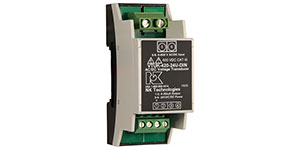Maximize Motor and Drive Operating Life Prevent System Failures with new VTD High Performance Voltage Transducer from NK Technologies
 NK Technologies introduces VTD Series high-performance voltage transducers. Packaged in a compact and easy-to-install 35mm wide DIN-rail enclosure, the VTD series senses voltage in a wide variety of DC powered installations, including industrial motors, battery chargers, photovoltaic arrays and wind generators. These cost-effective voltage transducers help avoid motor overheating by detecting below normal voltage conditions, and detect voltage conditions that can stress or damage starter components. Monitoring DC voltage enables operators to know that the system is ready even before there is a load connected to it.
NK Technologies introduces VTD Series high-performance voltage transducers. Packaged in a compact and easy-to-install 35mm wide DIN-rail enclosure, the VTD series senses voltage in a wide variety of DC powered installations, including industrial motors, battery chargers, photovoltaic arrays and wind generators. These cost-effective voltage transducers help avoid motor overheating by detecting below normal voltage conditions, and detect voltage conditions that can stress or damage starter components. Monitoring DC voltage enables operators to know that the system is ready even before there is a load connected to it.
VTD voltage transducers can be used on circuits from 0-15 VDC to 0-600 VDC to satisfy a wide range of voltage monitoring needs. Fully isolated and industry standard 4-20mA loop-powered output makes use with existing controllers, data loggers and SCADA equipment easy and reliable. Additionally, input and output circuitry is fully isolated to maximize operational safety.
“Direct current is used in many industrial processes. In most cases, AC power is used for delivery of the power, and then converted to DC though electronic modification. Computers use 5 and 12 volts DC, servo motors operate with voltages from lower than ten to 200 or much higher, and large DC motors often are designed to use 750 VDC,” says Philip Gregory, President, NK Technologies. “Since the speed of the motor is directly proportional to the voltage supplied, DC motors have historically been the first choice for moving loads at varying speeds. From system control to heavy lifting, DC power is used all over the plant.”
With the renewed interest in alternative power sources, DC systems are found in photovoltaic solar power and wind power generation. Photovoltaic systems produce low voltage DC power from each cell, and each cell is connected in series to boost the voltage to higher levels so the effect of impedance is minimized. Wind generators are often designed to charge batteries at 12 or 24 volts, and some produce DC voltages to 240 depending on the need or application.


